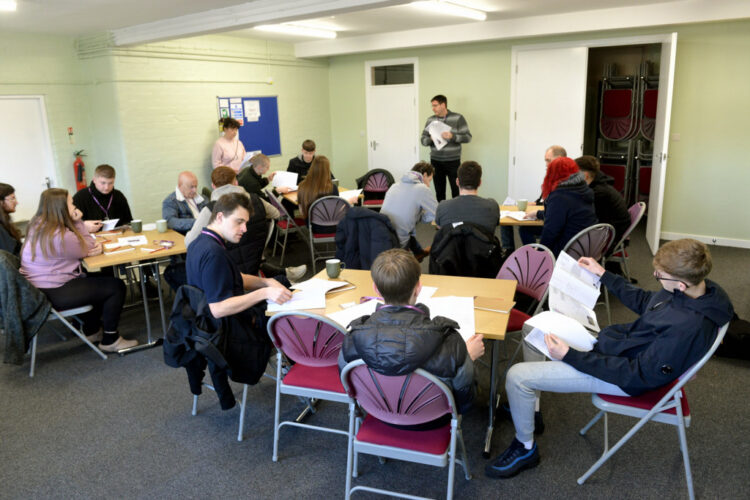Plans are under discussion to transform a former bank building in Barnard Castle into an access for the town’s ancient fortress and potentially create a ‘guild house’. Martin Paul dropped into a recent briefing with students…
COLLEGE students were invited earlier this month to come up with their own plans on how the former Natwest Bank building in Barnard Castle can be transformed into a new way to create access to the town’s ancient fortress.
Also a potential part of the project is to use the upper floors as a guild hall, making the town a centre for heritage skills and offer a place for journeymen to stay while working in the area.
The idea is being discussed between English Heritage, Historic England, Raby Estates, Durham County Council and Cultura Trust. However, Trades4Care, which offers on-the-job experience for students in trades to gain experience alongside qualified professionals, used the opportunity to allow young people from New College Durham, Bishop Auckland College, and Bridge Creative to give their input and ideas for the building and its rear garden.
Before starting, the students met at St Mary’s Parish Hall where they were briefed on the history of the building by Durham County Council conservation officer Bryan Harris, and given an overview of the project proposal by Trades4Care director and Cultura Trust member Deborah Jenkins.
Mr Harris explained that while the building is listed, its Victorian frontage is a deception of its true history.
He added that a building historian had been employed to look at detailed records of the building and its past.
The conservation officer said: “Once we did more research, we began to understand that there is a much stronger link between the building and the castle behind it. It turns out the building isn’t 1890 at all, it is early 1720s.
“Don’t be fooled by what you see on the front… In reality, it is a building that has had a 1890s frontage put on it, but everything behind it is very different.”
He said the original building was “probably the most prestigious residence” in the town at the time, owned by someone of great importance. The building’s garden once extended into the castle ward.
Mr Harris said: “One of the things we would like to do as part of the project is to go through a [what is now brick] wall and link the property to the castle. There is historic reasoning for doing that. There is historic justification.”
He noted that the various upper floors were very different from the ground floor, which had been stripped out to accommodate the bank. The first floor retains much of its original panelling and the top floor has smaller, simpler rooms that might once have been servant accommodation.
He urged the students to look at different uses and not be shy to use modern interventions. He also asked them to think about what visitors might expect when travelling through the building to get to the ancient castle.
The students, all of whom are on courses for bricklaying, decorating and joinery, were divided into four groups, each with an experienced mentor, to draw up plans for the various sections of the building and to do a final presentation to “clients” at the end of the day.
Ms Jenkins told the students more about the potential of creating a guild house in the town. She explained that while guild houses continue to operate around Europe, there are none left in the UK.
She said: “A guild hall is a place where journeymen – that is people who finish their apprenticeship but who are going around the country, or Europe – can stay for six months or a year while working on heritage projects in the area.”
She said the top floor would provide accommodation, while the first floor could be living area as well as a meeting place or where visiting craftspeople could give talks or lectures.
She added: “It is very much about heritage skills and being a focus for people locally and further afield who are interested in heritage skills.”
She added that there was a huge shortage of heritage stonemasons, carpenters and joiners to work on the many historic buildings in the country.
Ms Jenkins said: “Raby Estates is really supportive because they themselves need stonemasons and joiners who can work on their buildings.
“Anyone wanting to go into a trade has an infinite variety of possibilities. It has got no ceiling.”




